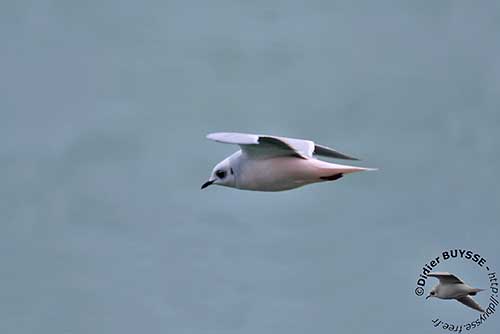
Fr: Mouette de Ross – Mouette rosée
Ang: Ross’s Gull
All: Rosenmöwe
Esp: Gaviota Rosada
Ita: Gabbiano polare di Ross
Nd: Ross' Meeuw
Sd: Rosenmås
Photographers:
John Anderson
John Anderson Photo Galleries
Didier Buysse
Vision d’Oiseaux
Tom Grey
Tom Grey's Bird Pictures & Tom Grey's Bird Pictures 2
Alan & Ann Tate
AA Bird Photography
Text by Nicole Bouglouan
Sources:
HANDBOOK OF THE BIRDS OF THE WORLD Vol 3 by Josep del Hoyo-Andrew Elliott-Jordi Sargatal - Lynx Edicions - ISBN : 8487334202
THE HANDBOOK OF BIRD IDENTIFICATION FOR EUROPE AND THE WESTERN PALEARCTIC by Mark Beaman, Steve Madge - C. Helm - ISBN: 0713639601
L’ENCYCLOPEDIE MONDIALE DES OISEAUX - Dr Christopher M. Perrins - BORDAS - ISBN: 2040185607
Bird Web (Seattle Audubon Society)
What Bird-The ultimate Bird Guide (Mitchell Waite)
Wikipedia, the free encyclopaedia
All About Birds (Cornell Lab of Ornithology)
Solving the Mystery of Ross's Gulls
Mystery bird: Ross's gull, Rhodostethia rosea
Species at Risk Public Registry
BirdWatching: Breakthrough: Wintering grounds of Ross’s Gull revealed at last
Ross’s Gull
Rhodostethia rosea
Charadriiformes Order – Laridae Family
INTRODUCTION:
The Ross’s Gull is a small, dove-like gull, rarely seen outside of the high Arctic where it breeds in remote areas. In breeding plumage, the white underparts are conspicuously washed pink, and a narrow black ring can be seen around the neck, creating a beautiful contrast with the pale plumage.
This scarce and nice gull is among the most sought-after birds in NW Europe and N America. As soon as this species appears somewhere, numerous bird-lovers are able to travel long distances to see it.
The Ross’s Gull is named after the great Arctic explorer James Clark Ross, who described this bird for the first time in 1823.

DESCRIPTION OF THE BIRD:
Biometrics:
Length: 29-32 cm
Wingspan: 82-92 cm
Weight: 120-250 g
The Ross’s Gull has relatively long wings and wedge-shaped tail. The adult in breeding plumage has pale grey upperparts. On the upperwing, secondaries and tips to inner primaries are white, whereas the outermost primary shows dark outer web. During summer, a narrow, black ring encircles the upper neck. The white underparts are usually washed pink. The underwing-coverts are dark grey with broad white trailing edge.
The bill is black. The eyes are dark brown surrounded by red eyering. Legs and webbed feet are bright red or reddish-orange.

The Ross’s Gull in non-breeding plumage lacks the black collar and the pink wash (or it is very pale). The crown may appear pale greyish and the eyes are surrounded by indistinct blackish flecks. There is a small, black spot on the ear-coverts. Trailing edge, uppertail coverts and rectrices are white.

The juvenile has blackish-brown mantle, scapulars, crown, hindneck and sides of breast.
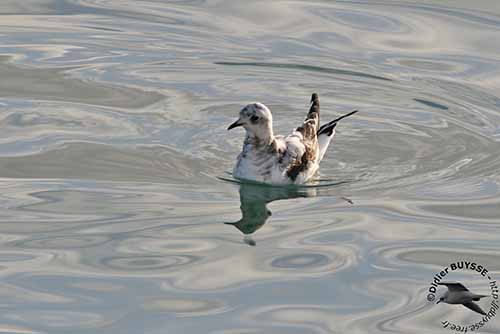
The first winter has pale grey crown, hindneck, neck sides and breast, contrasting slightly with the whiter hood. In flight, secondaries and inner primaries are very white and the W pattern on the upperwing is black. On the uppertail, the central rectrices are tipped black.
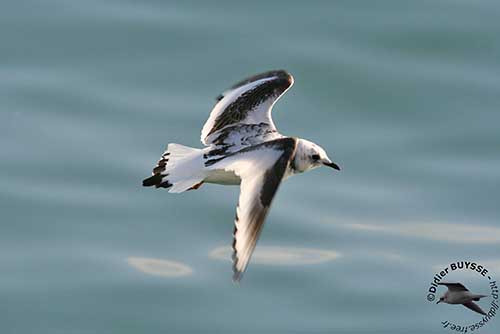
RANGE:
The Ross’s Gull breeds in NE Siberia, from Taymyr Peninsula E to Kolyma River. It also breeds locally in Greenland and irregularly in N Canada. It winters mainly in Arctic, but their wintering grounds are poorly known.
However, from recent observations by the High Arctic Gull Research Group based in Bamfield, Vancouver Island, a very small colony has been found on a small Arctic island. Some birds were tagged with electronic locators in order to follow them through the winter.
The gulls overwinter off the very inhospitable coasts of Labrador, which explains what this species has not been seen before. But this harsh environment appears very suitable for the Ross’s Gull.
HABITAT:
The Ross’s Gull breeds in a variety of Arctic habitats, among open wet tundra, in marshy tundra, large bogs in forest, gravel reefs, usually always near water. They often breed close to colonies of Arctic Terns. The known sites are hummocks covered with grass, dwarf willows, and areas with grasses and sedges close to pools and shallow lakes.
Nesting sites have been found on low-lying gravel reefs close to polynyas and opening in the sea ice.
Outside breeding season, the Ross’s Gull is found in open seas and at the edge of the pack ice. Vagrants are often seen with other Laridae at coastal sites.
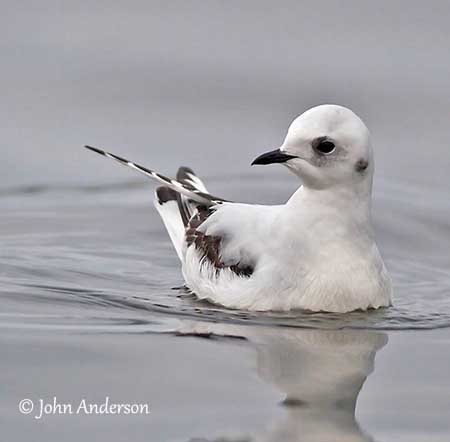
CALLS AND SONGS: SOUNDS BY XENO-CANTO
The Ross’s Gull gives high-pitched and more melodious calls than most Laridae species. On the breeding grounds, it gives short, dry, yapping calls “a-dac a-dac a-dac” or “de-urr de-urr”. The alarm call is a rapid series “kik kik kik kik kik”. During winter, vagrants give soft, high “kew”.
BEHAVIOUR IN THE WILD:
The Ross’s Gull feeds mainly on insects during the breeding season. During migrations and winter, it feeds on crustaceans, small fish, marine worms and probably plankton. It also takes carrion and refuse occasionally.
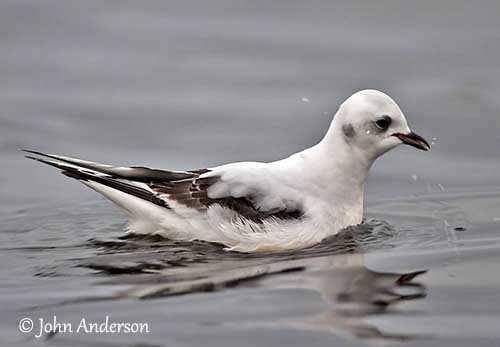
During the breeding season, the Ross’s Gull often benefits from the aggressive defence behaviour of the Arctic Tern.
Some courtship displays can be observed, with two birds facing each other with raised tails while giving soft calls. Another display shows the birds close to each other and standing side by side, and then circling each other by walking.
The Ross’s Gull nests in loose colonies of 2-10 pairs, with the nests placed between 45 and 100 metres apart, rarely less than 5 metres.
The adults defend the chicks aggressively against intruders and predators, and often perform various distraction displays to lead them away from the colony.
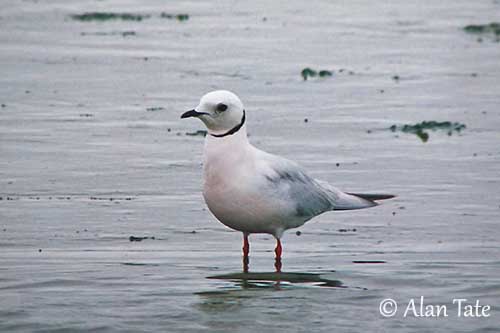
The Ross’s Gull is migratory and moves N to Arctic Ocean by late July after breeding. Then, every autumn, they migrate E or W along the coast or pack ice’s edge.
It returns to the breeding grounds in late May, depending on snow and ice conditions. However, the movements of this species are still poorly known. Flocks are recorded in some places, but their migrations need to be more studied.
The Ross’s Gull has quick flight action, somewhat pigeon-like, with rapid direct flight on long wings and performing rapid wingbeats. It also hovers while foraging.

REPRODUCTION OF THIS SPECIES:
The Ross’s Gull spends about two months on its breeding grounds, and the laying occurs in early to mid-June. It breeds in loose colonies in tussocks on islands, in tundra or taiga pools, among willow scrub, in marshy and wooded areas, often on hummock and close to water.
The nest is a shallow depression in the ground, made with grass, sedge and moss, and lined with dry grass and pieces of other plant material.
The female lays 1-3 eggs and both adults share the incubation during three weeks. At hatching, the downy chicks are yellowish to rusty-brown with dark spots and lines on crown, back and wings. The underparts are whitish.
The adults lead the chick away from the colony one week after hatching, and they are unattended. The young birds form groups at water edges. They fledge about 20 days after hatching.
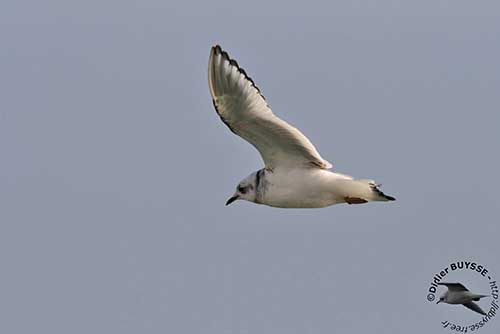
PROTECTION / THREATS / STATUS:
The Ross’s Gull is often attacked by the Peregrine Falcon whereas eggs and chicks are taken by larger gulls, arctic foxes and polar bears. Human disturbances at nesting sites in Churchill area have led to abandon of nests. The development of oil extraction in Beaufort and Chukchi Seas is a potential threat for the large concentrations of Ross’s Gulls during the autumn. Effects of climate change are currently unknown, but could have a negative impact on the reproduction of the species.
The population is estimated to number 25,000/100,000 individuals (2006). The Ross’s Gull is currently evaluated as Least Concern, and benefits from several protections.
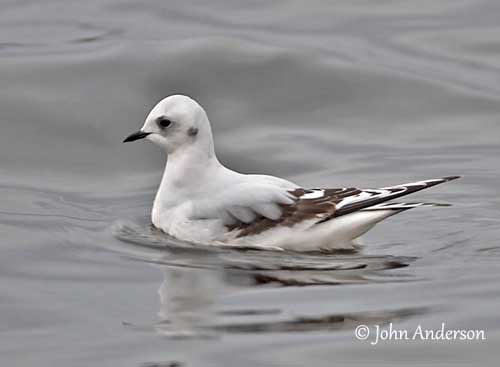
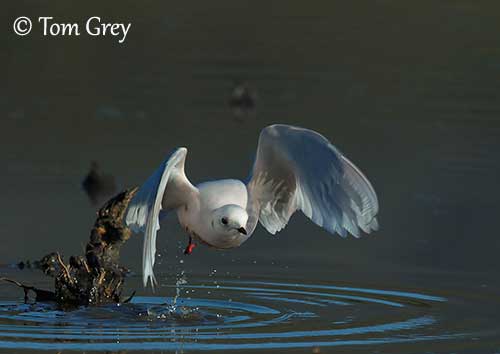
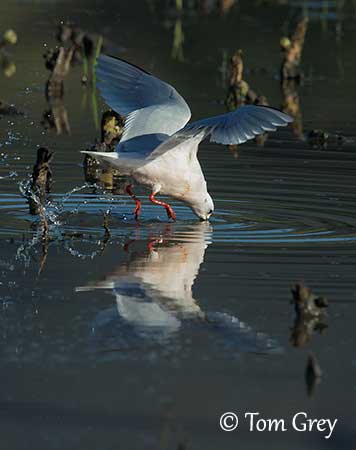
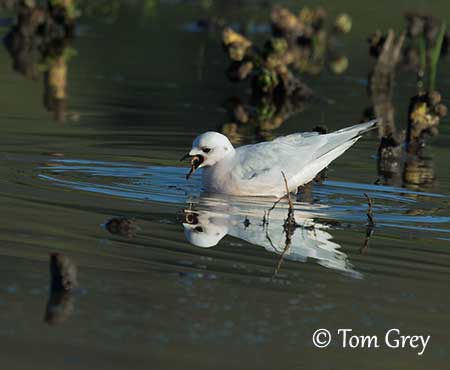

This Ross’s Gull was observed during three days in California in January 2017, very far from its usual range. Unfortunately, the bird has been killed by a pair of Peregrine Falcons.